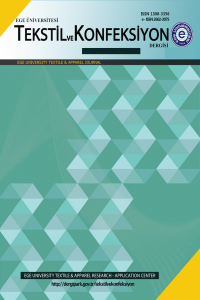EXPERIMENTAL STUDY AND NUMERICAL SIMULATION OF THE AIR PERMEABILITY OF SYSTEMS OF WOVEN MACROSTRUCTURES
EXPERIMENTAL STUDY AND NUMERICAL SIMULATION OF THE AIR PERMEABILITY OF SYSTEMS OF WOVEN MACROSTRUCTURES
Air pPermeability; System of layers; Woven macrostructures; Computational Fluid Dynamics.,
___
- 1. Angelova, R.A., Stankov, P., Simova, I., and Aragon I., Three Dimensional Simulation ofAir Permeability of Single Layer Woven Structures, Cent. Eur. J. Eng. 1 (4), 430-435 (2011).
- 2. Ogulata R. T. (2006). Air permeability of woven fabrics. J Textile Apparel, Technology and Management. 5 (2), 1-10.
- 3. Angelova R. A., P. Stankov, I. Simova, and M. Kyosov (2013). Computational Modeling and Experimental Validation of the Air Permeability of Woven Structures on the Basis of Simulation of Jet Systems. Text. Res. J. 83 (18), 1887-1895.
- 4. Peirce F. T. and F. T. Womersley (1978). Cloth Geometry. Manchester, England: Text. Institute.
- 5. Seyam A. and A. El-Shiekh (1993). Mechanics of Woven Fabrics. Text. Res. J. 63 (2), 371-378.
- 6. Dubrovski P. D. and M. Brezocnik (2002). Using Genetic Programming to Predict the Macroporosity of Woven Cotton Fabrics. Text. Res. J. 72 (3), 187-194.
- 7. Jakšic D. and N. Jakšic (2007). Assessment of Porosity of Flat Textile Fabrics. Text. Res. J. 77 (2), 105-110.
- 8. Zupin Z., A. Hladnik and К. Dimitrovski (2012). Prediction of One-Layer Woven Fabrics Air Permeability Using Porosity Parameters. Text. Res. J. 82 (1),117-128.
- 9. Fatahi, II., and Alamdar, Y. А., “Assessment of the Relationship between Air Permeability of Woven Fabrics and Its Mechanical Properties”, Fib Text East Europe. 18 (6), 68-71, (2010).
- 10. Havlova, M., “Influence of Vertical Porosity on Woven Fabric Air Permeability”, 7th International Conference - TEXSCI 2010, Liberec, Czech Republic, (2010).
- 11. Nabovati A., E. W. Llewellin and A. C. M. Sousa (2010). Through-thickness permeability prediction of 3D multifilament woven fabrics, Composites. Part A 41,453-463.
- 12. Rief S., E. Glatt, E. Laourine, et al. (2011). Modelling and CFD-Simulation of Woven Textiles to Determine Permeability and Retention Properties. AUTEX Res J. 11, 78-83.
- 13. Banks-Lee, P., Mohammadi, M., and Ghadimi, P., “Utilization of Air Permeability in Predicting the Thermal Conductivity”, Int. Nonwovens J. 13(2), 28-33 (2004).
- 14. Gooijer H., M. M. C. G. Warmoeskerken. and J. Groot Wassink (2003a). Flow Resistance of Textile Materials Part I: Monofilament Fabrics. Text. Res. J. 73(5), 437-443.
- 15. Gooijer H., M. M. C. G. Warmoeskerken. and J. Groot Wassink (2003b). Flow Resistance of Textile Materials Part II: Multifilament Fabrics. Text. Res. J. 73(6), 480-484.
- 16. Belov E. B., S. V. Lomov, I. Verpoest, T. Peters, D. Roose, R. S. Parnas, K. Hoes and H. Sol (2004). Modelling of permeability of textile reinforcements: lattice Boltzmann method, Compos Sci and Tech. 64 (7–8), 1069-1080.
- 17. Verleye B., M. Klitz, R. Groce, D. Roose, S. V. Lomov and I. Verpoest (2007). Computation of the permeability of textiles with experimental validation for monofilament and non crimp fabrics. Studies in Computational Intelligence, Springer.
- 18. Wang Q., B. Maze, H. V. Tafreshi (2007). On the pressure drop modeling of monofilament-woven fabrics. Chemical Eng. Science. 62 (17), 4817-4821.
- 19. Grouve, W. J. B., Akkerman, R., Loendersloot, R., and van den Berg, S. (2008), “Transverse permeability of woven fabrics”, 11th ESAFORM Conference on Material Forming, April 23-25, Lyon, France, (2008).
- 20. Matusiak M. (2015) Application of Artificial Neural Networks to Predict the Air Permeability of Woven Fabrics. Fibers & Text. in Eastern Europe. 23 (1), 41-48.
- 21. Unal P., M. Üreyen, and D. Mecit (2012), Predicting Properties of Single Jersey Fabrics using Regression and ANN Models, Fibers and Polymers. 13 (1), 87-95.
- 22. Afzal A., T. Hussain, M. Malik, A. Rasheed, S Ahmad, A. Basit and A. Nazir (2014). Investigation and Modeling of Air Permeability of Cotton/Polyester Blended Double Layer Interlock Knitted Fabrics. Fibers and Polymers. 15 (7), 1539-1547.
- 23. Xiao X., A. Long and X. Zeng (2014). Through-thickness permeability modelling of woven fabric under out-of-plane deformation. J Mater Sci. 49 7563-7574.
- 24. Angelova R. A. (2016). Textiles and Human Thermophysiological Comfort in the Indoor Environment. CRC Press, Taylor and Francis Group, Boca Raton, FL, USA.
- 25. ISO 3801:2011, Textiles -– Woven fabrics -– Determination of mass per unit length and area, IOS, Switzerland.
- 26. EN ISO 5084:201302. Textiles -– Determination of thickness of textiles and textile products. IOS, Switzerland.
- 27. ISO 7211-2:20101984, Textiles -– Woven fabrics -– Construction - Methods of analysis - Part 2, IOS, Switzerland.
- 28. Angelova R. A. (2012). Determination of the Pore Size of Woven Structures through Image Analysis, Cent. Eur. J. Eng. 2 (1), 129-135.
- 29. Mezarcioz S., S. Mezarcioz, R.T. Ogulata, Prediction of the Air Permeability of Knitted Fabrics by Means of Computational Fluid Dynamics, Tekstil ve KonfeksiyonEKSTİL ve KONFEKSİYON 24(2), pp. 202-211, 2014.
- 30. EN ISO 9237:20111999. Textiles-Determination of permeability of fabrics to air, IOS, Switzerland.
- ISSN: 1300-3356
- Yayın Aralığı: Yılda 4 Sayı
- Başlangıç: 1991
- Yayıncı: Ege Üniversitesi
TEKSTİL TERBİYESİNDE NANO BOYUTTA KİTOSANIN YEŞİL UYGULAMASI
R. A. ANGELOVA, E. GEORGIEVA, M. KYOSOV, P. STANKOV
PASTAL PLANI VERİMLİLİĞİNİ ETKİLEYEN FAKTÖRLER İLE İLGİLİ BİR ÇALIŞMA
Oktay PAMUK, Esra Zeynep YILDIZ
FARKLI TABAKLAMA MADDELERİ İLE İŞLEM GÖRMÜŞ DERİLERİN TERMOFİZYOLOJİK KONFOR ÖZELLİKLERİ
Selime Menteş ÇOLAK, Nilgün ÖZDİL, Mustafa EKİNCİ, Ömer KAPLAN
İPEK LİFLERİNDE ALTERNATİF ÇEVRE DOSTU YÖNTEMLERLE SERİSİN GİDERME
Pervin ANİŞ, Gökşen ÇAPAR, Tuba TOPRAK, Eyüphan YENER
INFLUENCE OF MULTIPLE LAUNDERING ON COTTON SHIRTS PROPERTIES
Emilija TOSHIKJ, Igor JORDANOV, Goran DEMBOSKI, Biljana MANGOVSKA
HAZIR GİYİM SEKTÖRÜNDE KATMA DEĞER YARATMA SÜRECİNİN ANALİZİ: “TÜRKİYE ÖRNEĞİ”
TÜRK TEKSTİL VE KONFEKSİYON SANAYİLERİNİN DOĞRUSAL OLMAYAN DİNAMİKLERİNİN ANALİZİ
